Engage NY Eureka Math Algebra 2 Module 3 Lesson 7 Answer Key
Eureka Math Algebra 2 Module 3 Lesson 7 Opening Exercise Answer Key
Opening Exercise:
Work with your partner or group to solve each of the following equations for x.
a. 2x = 23
Answer:
x = 3
b. 2x = 2
Answer:
x = 1
c. 2x = 16
Answer:
2x = 24
x = 4
d. 2x – 64 = 0
Answer:
2x = 64
2x = 26
x = 6
e. 2x – 1 = 0
Answer:
2x = 1
2x = 20
x = 0
f. 23x = 64
Answer:
23x = 26
3x = 6
x = 2
g. 2x + 1 = 32
Answer:
2x + 1 = 25
x + 1 = 5
x = 4
Eureka Math Algebra 2 Module 3 Lesson 7 Example Answer Key
Example 1.
The Es Cheri chia coil bacteria (commonly known as E. coil) reproduces once every 30 minutes, meaning that a colony of E. coil can double every half hour. Mycobacterium tuberculosis has a generation time in the range of 12 to 16 hours. Researchers have found evidence that suggests certain bacteria populations living deep below the surface of the earth may grow at extremely slow rates, reproducing once every several thousand years. With this variation in bacterial growth rates, it is reasonable that we assume a 24-hour reproduction time for a hypothetical bacteria colony in this example.
Suppose we have a bacteria colony that starts with 1 bacterium, and the population of bacteria doubles every day. What function P can we use to model the bacteria population on day t?
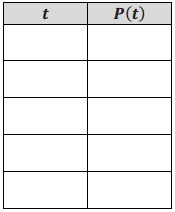
Answer:
P(t) = 2t, for real numbers t ≥ 0.
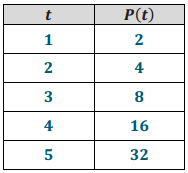
How many days will it take for the bacteria population to reach 8?
Answer:
It will take 3 days because P(3) = 23 = 8.
How many days will It take for the bacteria population to reach 16?
Answer:
It will take 4 days because P(4) = 24 = 16.
Roughly how long will it take for the population to reach 10?
Answer:
Between 3 and 4 days; the number d so that 2d = 10
We already know from our previous discussion that if 2d = 10, then 3 < d < 4, and the table confirms that. At this point, we have an underestimate of 3 and an overestimate of 4 for d. How can we find better under and over estimates ford?

Answer:
(Note to teacher: Once students respond, have them volunteer values to complete the table.)
Calculate the values of 23.1, 23.2, 23.3 etc., until we find to consecutive values that have 10 between them.
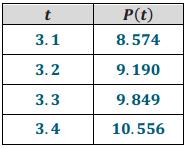
From our table, we now know another set of under and overestimates for the number d that we seek. What are they?
Answer:
We know d is between 3.3 and 3.4. That is, 3.3 < d < 3.4.
Continue this process of “squeezing” the number d between two numbers until you are confident you know the value of d to two decimal places.
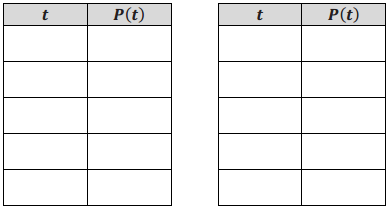
Answer:

Since 3.321 < d < 3.322, and both numbers round to 3.32, we can say that d ≈ 3.32. We see that the population reaches 10 after 3.32 days (i.e., 23.32 ≈ 10).
What if we had wanted to find d to 5 decimal places?
Answer:
Keep squeezing d between under and overestimates until they agree to the first 5 decimal places. (Note to teacher: To 5 decimal places, 3.321928 < d < 3.321929, so d ≈ 3.32193.)
To the nearest minute, when does the population of bacteria become 10?
Answer:
It takes 3.322 days, which is roughly 3 days, 7 hours, and 43 minutes.
Eureka Math Algebra 2 Module 3 Lesson 7 Exercise Answer Key
Exercise 1.
Use the method from the Example to approximate the solution to the equations below to two decimal places.
a. 2x = 1000
Answer:
x ≈ 9.97
b. 3x = 1000
Answer:
x ≈ 6.29
c. 4x = 1000
Answer:
x ≈ 4.98
d. 5x = 1000
Answer:
x ≈ 4.29
e. 6x = 1000
Answer:
x ≈ 3.86
f. 7x = 1000
Answer:
x ≈ 3.55
g. 8x = 1000
Answer:
x ≈ 3.32
h. 9x = 1000
Answer:
x ≈ 3.14
i. 11x = 1000
Answer:
x ≈ 2.88
j. 12x = 1000
Answer:
x ≈ 2.78
k. 13x = 1000
Answer:
x ≈ 2.69
l. 14x = 1000
Answer:
x ≈ 2.62
m. 15x = 1000
Answer:
x ≈ 2.55
n. 16x = 1000
Answer:
x ≈ 2.49
Eureka Math Algebra 2 Module 3 Lesson 7 Problem Set Answer Key
Question 1.
Solve each of the following equations for x using the same technique as was used in the Opening Exercise.
a. 2x = 32
Answer:
x = 5
b. 2x – 3 = 22x + 5
Answer:
x = -8
c. 2x2 – 3x = 2-2
Answer:
x = 1 or x = 2
d. 2x – 24x – 3
Answer:
x = 1
e. 23x . 25 = 27
Answer:
x = \(\frac{2}{3}\)
f. 2x2 – 16 = 1
Answer:
x = 4 or x = -4
g. 32x = 27
Answer:
x = \(\frac{3}{2}\)
h. 3\(\frac{2}{x}\) = 81
Answer:
x = \(\frac{1}{2}\)
i. \(\frac{3^{x^{2}}}{3^{5 x}}\) = 36
Answer:
x = 6 or x = -1
Question 2.
Solve the equation \(\frac{2^{2 x}}{2^{x+5}}\) = 1 algebraically using two different initial steps as directed below.
a. Write each side as a power of 2.
Answer:
22x – (x + 5) = 20
x – 5 = 0
x = 5
b. Multiply bothsides by 2x + 5
Answer:
22x = 2x + 5
2x = x + 5
x = 5
Question 3.
Find consecutive integers that are under and overestimates of the solutions to the following exponential equations.
a. 2x = 20
Answer:
24 = 16 and 25= 25, so 4< x < 5.
b. 2x = 100
Answer:
26 = 64 and 27 = 128, so 6 < x < 7.
c. 3x = 50
Answer:
33 = 27 and 34 = 81, so 3 < x < 4.
d. 10x = 432,901
Answer:
105 = 100,000 and 106 = 1,000, 000, so 5 < x < 6.
e. 2x – 2 = 750
Answer:
29 = 512 and 210 = 1,024, so 9 < x – 2 < 10; thus, 11< x <12.
f. 2x = 1.35
Answer:
20 = 1 and 21 =2, so 0 < x < 1.
Question 4.
Complete the following table to approximate the solution to 10x = 34, 198 to three decimal places.

Answer:

10x = 34,198
104.543 ≈ 34.198, so x ≈ 4.534
Question 5.
Complete the following table to approximate the solution to 2x = 19 to three decimal places.
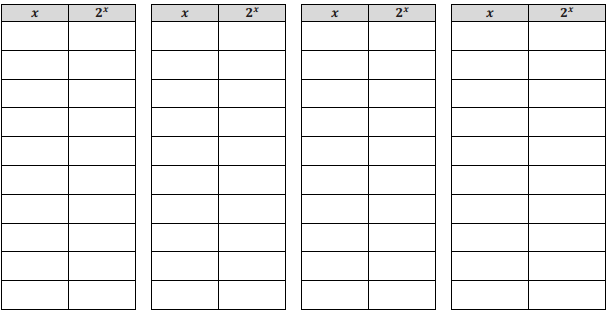
Answer:
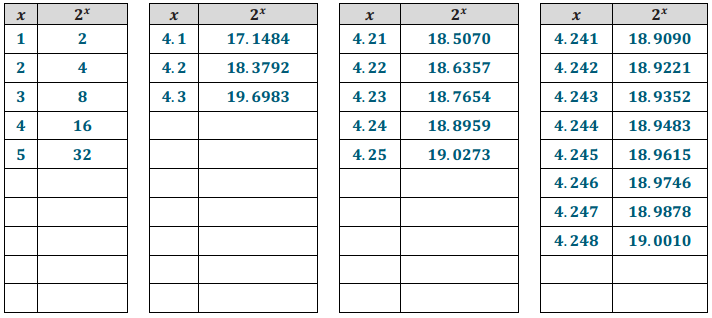
2x = 19
24.248 ≈ 19, so x ≈ 4.248
Question 6.
Approximate the solution to 5x = 5555 to four decimal places.
Answer:
Since 55 = 3125 and 56 = 15625, we know that 5 < x < 6.
Since 55.3 ≈ 5064.5519 and 55.4 ≈ 5948.9186, we know that 5.3 < x < 5.4.
Since 55.35 ≈ 5488.9531 and 55.36 ≈ 5578.0092, we know that 5.35 < x < 5.36.
Since 55.357 ≈ 5551.1417 and 55.358 ≈ 5560.0831, we know that 5.357 < x < 5.358.
Since 55.3574 ≈ 5554.7165 and 55.3575 ≈ 5555.6106, we know that 5.3574 < x < 5.3575.
Since 55.35743 ≈ 5554.9847 and 55.35744 ≈ 5555.0741, we know that 5.35743 < x < 5.35744.
Thus, the approximate solution to this equation to four decimal places is 5.3574.
Question 7.
A dangerous bacterial compound forms in a closed environment but is immediately detected. An initial detection reading suggests the concentration of bacteria In the closed environment is one percent of the fatal exposure level. This bacteria is known to double in concentration in a closed environment every hour and can be modeled by the function P(t) = 100 . 2t, where t is measured in hours.
a. In the function P(t) = 100 . 2t, what does the 100 mean? What do the 2 mean?
Answer:
The 100 represents the initial population of bacteria, which is 1% of the fatal level. This means that the fatal level occurs when P(t) = 10,000. The base 2 represents the growth rate of the bacteria; It doubles every hour.
b. Doctors and toxicology professionals estimate that exposure to two-thirds of the bacteria’s fatal concentration level will begin to cause sickness. Without consulting a calculator or other technology, offer a rough time limit for the inhabitants of the infected environment to evacuate in order to avoid sickness.
Answer:
The bacteria level is dangerous when P(t) = 100 . 2t = \(\frac{2}{3}\)(10 000) ≈ 6666.67.
Since 26 = 64, P(6) ≈ 6400, inhabitants of the infected area should evacuate within 6 hours.
c. A more conservative approach is to evacuate the infected environment before bacteria concentration levels reach one-third of fatal levels. Without consulting a calculator or other technology, offer a rough time limit for evacuation in this circumstance.
Answer:
Under these guidelines, the bacteria level is dangerous when P(t) = 100 2t = \(\frac{1}{3}\)(10,000) = 3333.33. Since 25 = 32, P(5) ≈ 3200, so the conservative approach is to recommend evacuation within 5 hours.
d. Use the method of the Example to approximate when the bacteria concentration will reach 100% of the fatal exposure level, to the nearest minute.
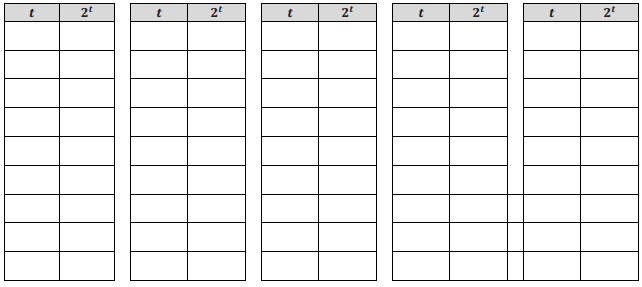
Answer:
We need fo approximate the solution to 100 . 2t = 10,000, which is equivalent to solving 2t = 100.

Inhabitants need to evacuate within 6.644 hours, which is approximately 6 hours and 39 minutes.
Eureka Math Algebra 2 Module 3 Lesson 7 Exit Ticket Answer Key
Question 1.
Loggerhead turtles reproduce every 2 to 4 years, laying approximately 120 eggs in a clutch. Using this information, we can derive an approximate equation to model the turtle population. As is often the case in biological studies, we will count only the female turtles.
If we start with a population of one female turtle in a protected area and assume that all turtles survive, we can roughly approximate the population of female turtles by T(t) = 5. Use the methods of them Example to find the number of years, Y, it will take for this model to predict that there will be 300 female turtles. Give your answer to two decimal places.
Answer:
Since 53 = 125 and 54 = 625, we know that 3 < Y <4.
Since 53.5 ≈ 279.5084 and 53.6 ≈ 328.3160, we know that 3.5 < Y < 3.6.
Since 53.54 ≈ 298.0944 and 53.55 ≈ 302.9308, we know that 3.54 < Y <3.55.
Since 53.543 ≈ 299.5372 and 53.544 ≈ 300.0196, we know that 3.543 < Y < 3. 544.
Thus, to two decimal places, we have Y ≈ 3.54. So, it will take roughly 3\(\frac{1}{2}\) years for the population to grow to 300 female turtles.